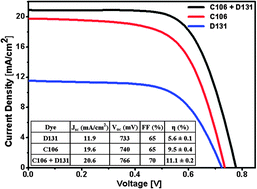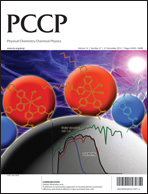Ruthenium-based C106 and organic D131 sensitizers have been judicially chosen for co-sensitization due to their complementary absorption properties and different molecular sizes. Co-sensitization yields a higher light-harvesting efficiency as well as better dye coverage to passivate the surface of TiO2. The co-sensitized devices C106 + D131 showed significant enhancement in the performance (η = 11.1%), which is a marked improvement over baseline devices sensitized with either D131 (η = 5.6%) or C106 (η = 9.5%). The improved performance of the co-sensitized cell is attributed to the combined enhancement in the short circuit current, open circuit voltage, and the fill-factor of the solar cells. Jsc is improved because of the complementary absorption spectra and favorable energy level alignments of both dyes; whereas, Voc is improved because of the better surface coverage helping to reduce the recombination and increase the electron life time. The origins of these enhancements have been systematically studied through dye desorption, absorption spectroscopy, and intensity modulated photovoltage spectroscopy investigations.

You have access to this article
 Please wait while we load your content...
Something went wrong. Try again?
Please wait while we load your content...
Something went wrong. Try again?


 Please wait while we load your content...
Please wait while we load your content...